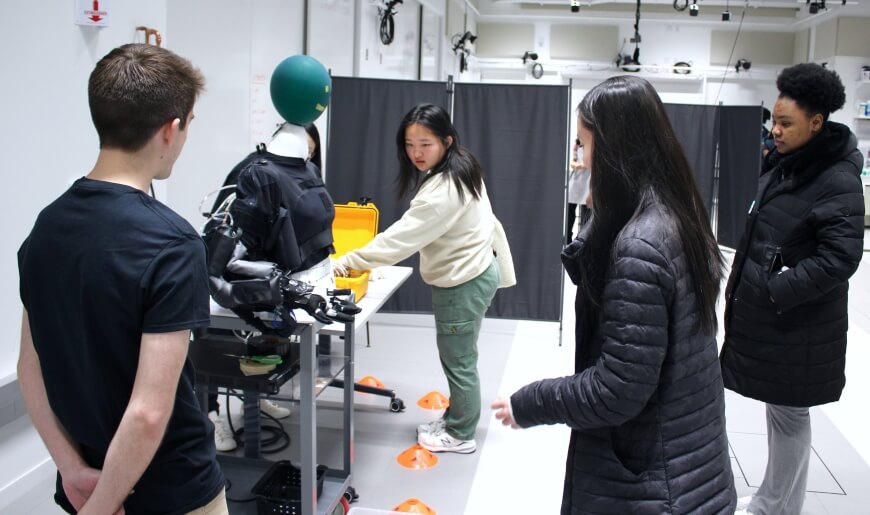News
High school students manipulate a Harvard Biodesign Lab upper-extremity exosuit at Biomechanics Outreach Day at the Science and Engineering Complex. (Harvard Biodesign Lab)
Relatable real-world examples can be a great way to introduce new students to advanced concepts such as biomechanics. Seeing a family member physically impaired due to a stroke could inspire a student to design an assistive device like an exosuit. A baseball or softball pitcher studying their throwing form on video might consider how more advanced sensors and motion capture technology could further improve performance.
Students at the Harvard John A. Paulson School of Engineering and Applied Sciences (SEAS) recently used that approach for the Biomechanics Outreach Day at the Science and Engineering Complex. Students from Boston and Cambridge high schools came together for a day of hands-on projects, presentations, and explorations with the Harvard Biodesign Lab, which is led by Conor J. Walsh, Paul A. Maeder Professor of Engineering and Applied Sciences at SEAS. The event coincided with National Biomechanics Day in early April.
“It’s important for them to really be engaged in thinking about how biomechanics connects to their lives, and how they can use it in their communities,” said Krithika Swaminathan, event co-organizer and Ph.D. candidate in the Harvard Biodesign Lab. “We were inspired by the amount of interest we had last year, and our experiences running it. We tried to take our learnings from what worked well and what we thought we could improve on, and added some new elements this year.”
High school students and members of the Harvard Biodesign Lab at Biomechanics Outreach Day at the Science and Engineering Complex. (Harvard Biodesign Lab)
The Biodesign Lab set a goal of reaching out to more high schools than last year and achieved that aim. Swaminathan and Baker, both part of the organizing team last year, also wanted to bring in more lab members to help with planning, which was critical to expanding the scope of the event.
“It was a pretty big team effort in terms of getting all the stations and the design challenge up and running,” Swaminathan said. “A lot of our team was new this year, but that meant we had a lot of new ideas.”
The general structure of the day matched its 2022 counterpart, which was the first time the Biodesign Lab hosted an outreach event at the SEC. Students interacted with various measurement tools and devices at stations throughout the lab, participated in a discussion about the ethics of research, then designed their own devices as a final project. But whereas last year’s students all designed the same final project – an inflatable wrist brace – this year’s group could choose from a series of challenges.
“We divided them into small groups and gave them prompts,” said Lauren Baker, another co-organizer and Ph.D. candidate in the Biodesign Lab. “They got to choose from a variety of personas, such as a hypothetical patient who had a stroke two years ago, couldn’t really use their right hand or foot, but would still like to drive to see their grandchildren. Students could pick who they wanted to help and then think about ways to better understand and address their needs, which could be designing a new device or sensor.”
High school students present their poster at Biomechanics Outreach Day at the Science and Engineering Complex. (Harvard Biodesign Lab)
With the design phase of their projects done, the students then collected their ideas on posters and presented them – just like they might do in an engineering class at SEAS or in a research symposium at an academic conference.
“I think the students were able to relate to some of those personas, so that really helped with participation,” Swaminathan said. “Overall, I think the design challenge was definitely one of the highlights for the students. We had a team looking at dancers who wanted to improve their posture, and table tennis players trying to improve their reaction time. To see the research that the students were able to do in a short time and come up with a good problem statement was really neat.”
Sarah Sullivan, Clinical Research Manager at the Wyss Institute for Biologically Inspired Engineering at Harvard University, introduced three key ethical considerations in clinical research: “respect for persons,” meaning obtaining informed, voluntary and autonomous consent before beginning human trials; “beneficence,” meaning not causing harm, minimizing risks and maximizing benefits for those being studied; and “justice,” meaning seeking out an inclusive and diverse selection of participants.
“Ethics is the foundation of great innovation and at the heart of everything we do in the Walsh Lab,” Sullivan said. “The students engaged in thought experiments that conveyed the importance of conducting research, ethically — with the utmost respect for our volunteers and end users.”
Swaminathan, Baker and co-organizer Kate Zhou also increased the interactivity of the stations students visited earlier in the day. One station allowed students to control the shoulder and elbow of an upper-extremity exosuit on a mannequin, as they tried to drop a token into a bucket. Another placed electromyography sensors on students’ biceps, and as they flexed, a separate gripper would curl along with them. Students also built simple robot hands and had a chance to experience the state-of-the-art motion capture equipment, along with the data it can collect.
“We also started to think about how much data is collected on everyone everyday and how many algorithms are developed based on all of this data, and your algorithms can only be as good as the data you collect,” Baker said. “If you’re only collecting data from one subset of the population, then your algorithms will only predict things based on this group. So, it’s more important to consider more inclusive motion capture methods, so as to then think about more inclusive algorithm development.”
Topics: Academics, Bioengineering, K-12, Materials Science & Mechanical Engineering
Cutting-edge science delivered direct to your inbox.
Join the Harvard SEAS mailing list.
Press Contact
Matt Goisman | mgoisman@g.harvard.edu




